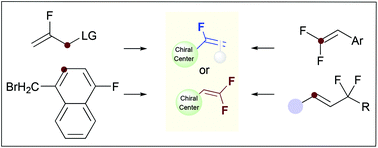Catalytic asymmetric synthesis of monofluoroalkenes and gem-difluoroalkenes: advances and perspectives
Abstract
Driven by the continuous demand for optically active fluoro-containing molecules from the chemical society, the field of fluorochemistry has emerged as a hot topic recently. While protocols focusing on catalytic asymmetric fluorination, (di)fluoroalkylation, and trifluoromethylation have been well developed, elegant strategies for the synthesis of enantioenriched monofluoro- and gem-difluoroalkenes remain highly sought after. As two vital subunits of organofluorides, both monofluoro- and gem-difluoroalkenes are pervasive within many biologically active molecules. They serve as the mimics of alkenyl, enol, and peptide bonds and the carbonyl group, respectively, which may enhance the bioactivities of the parent molecules. In addition, they are active handles for the construction of other fluorinated molecules. In this review, insightful discussions on the latest achievements of the catalytic asymmetric strategies associated with the facile synthesis of both monofluoro- and gem-difluoroalkenes are provided. The related mechanism considerations, applications in streamlining syntheses, limitations, and the opportunities of the state-of-the-art methodologies will be highlighted. We hope that this will trigger novel ideas, helping in pushing current frontiers further.

- This article is part of the themed collection: 2021 Organic Chemistry Frontiers Review-type Articles


 Please wait while we load your content...
Please wait while we load your content...